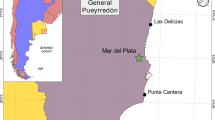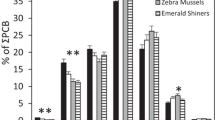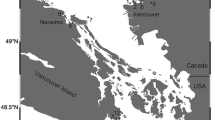Abstract
Polychlorinated biphenyl patterns were compared in samples of water, surface sediment, and the indigenous organisms ribbed mussels (Modiolus demissus), grass shrimp (Paleomonetes pugio), mummichogs (Fundulus heteroclitis), and eels (Anguila rostrata) collected from 1991 through 1993 at two stations in the highly contaminated New Bedford Harbor, Massachusetts. Principal component analysis of analytical data showed groups of points that corresponded to individual species, but little separation between stations for the same species was found. Linear correlations showed a high level of agreement between PCB patterns in samples of the exposure environment (water and sediments) and two species of organisms (ribbed mussels and mummichogs). However, due to two separate metabolic alterations of PCBs, the patterns in both shrimp and eels showed poor agreement with patterns in water and sediment. Selective enrichment factors (SEFs), the ratios of individual coplanar or mono-ortho substituted congeners to the total PCBs, were used to compare the relative abundance of congeners in samples. Due to metabolic differences, the SEFs were lower in eels and higher in shrimp than those found in Aroclor® standards.
Similar content being viewed by others
References
Albro PW, Corbett JT, Schroeder JL (1981) Quantitative characterization of polychlorinated biphenyl mixture (Aroclors® 1248, 1254, and 1260) by gas chromatography using capillary columns. J Chromatogr 205:103–111
Ankley GT, Tillitt DE, Giesy JP, Jones PD, Verbrugge DA (1991) Bioassay-derived 2,3,7,8-tetrachlorodibenzo-p-dioxin equivalents in PCB-containing extracts from the flesh and eggs of Lake Michigan Chinook salmon (Oncorhynchus tshawytscha) and possible implications for reproduction. Can J Fish Aquat Sci 48:1685–1690
Ballschmiter K, Zell M (1980) Analysis of polychlorinated biphenyls (PCBs) by glass capillary gas chromatography: Composition of technical Aroclor®- and Clophen-PCB mixture. Fresenius Zeitschrift Fur Analytische Chemie 302:201–231
Bergen BJ (1994) Science Applications International Corporation, c/o U.S. Environmental Protection Agency, 27 Tarzwell Dr., Narragansett, RI 02882. Personal communication
Black DE, Gutjahr-Gobell RE, Pruell RJ, Bergin BJ, McElroy AE (1993) PCB effects on Fundulus heteroclitus reproduction: Characterization of the relationship between endocrine function and reproductive success. Society of Environmental Toxicology and Chemistry Abstract #23, SETAC 14th Meeting, Nov. 1993, Houston, TX
Brown JF Jr (1992) Metabolic alterations of PCB residues in aquatic fauna: Distributions of cytochrome P4501a- and P4502B-like activities. Mar Environ Res 34:261–266
Brown JF Jr, Wagner RE (1990) Movement, dechlorination, and detoxication in the Acushnet estuary. Environ Toxicol Chem 9:1215–1233
Dillon TM, Burton WDS (1991) Acute toxicity of PCB congeners to Daphnia magna and Pimephales promelas. Bull Environ Contam Toxicol 46:208–215
Elskus AA, Stegeman JJ, Gooch JW, Black D, Pruell RJ (1994) Polychlorinated biphenyl congener distributions in winter flounder as related to gender, spawning site, and congener metabolism. Environ Sci Technol 28:401–407
Huckins JN, Stalling DL, Petty JD (1980) Carbon foam chromatographic separation of non-o,- chlorine substituted polychlorinated biphenyls from Aroclor® mixtures. J Assoc Anal Chem 63:750–755
Jansson B, Andersson R, Aspllund L, Litzen K, Nylund K, Sellstrom U, Uvemo U-B, Wahlberg C, Wideqvost U, Odsjo T, Olsson M (1993) Chlorinated and brominated persistent organic compounds in biological samples from the environment. Environ Toxicol Chem 12:1163–1174
Kafafi SA, Afeefy HY, Ali AH, Said HK, Kafafi AG (1993) Binding of polychlorinated biphenyls to the aryl hydrocarbon receptor. Environ Health Perspectives 101:422–428
Kannan N, Petrick G, Schulz D, Duinker J, Boon J, Van Arnhem E, Jansen S (1991) A comparison between activated charcoals and multidimensional GC in the separation and determination of (non-ortho CL substituted) toxic chlorobiphenyls. Chemosphere 23:1055–1076
Kannan N, Tanabe S, Tatskawa R (1988) Toxic potential of non-ortho and mono-ortho coplanar PCBs in commercial PCB preparations: “2,3,7,8-T4 CDD toxicity equivalence factor approach”. Bull Environ Contam Toxicol 41:267–276
Kannan N, Tanabe S, Tatsukawa R, Phillips DJH (1989) Persistence of highly toxic coplanar PCBs in aquatic ecosystems: Uptake and release kinetics of coplanar PCBs in green-lipped mussels (Perna viridis Linnaeus). Environ Pollut 55:65–76
Koistinen J, Paasivirta J, Vuorinen PJ (1989) Dioxins and other planar polychloroaromatic compounds in Baltic, Finnish, and Arctic fish samples. Chemosphere 19:527–530
Lake JL, Pruell RJ, Osterman FA (1992) An examination of dechlorination processes and pathways in New Bedford Harbor sediments. Mar Environ Res 33:31–47
Lake JL, Rubinstein NI, Pavignano S (1987) Predicting bioaccumulation: Development of a simple partitioning model for use as a screening tool for regulating ocean disposal of wastes. In: Dickson KL, Maki AW, Brungs WA (eds) Fate and effects of sediment-bound chemicals in aquatic systems. Pergamon Press, NY, pp 151–166
Lavine BK (1992) Signal processing and data analysis. In: Haskell SJ (ed) Practical guide to chemometrics. Marcel Dekker Inc., NY, pp 211–238
Mullin M (1987) Congeneric PCB methodology one-column system. U.S. Environmental Protection Agency, Large Lakes Research Station, 9311 Groh Rd., Grosse Ile, MI
Mullin M (1985) Congener Specific, PCB Analysis Techniques Workshop, EPA Large Lakes Research Station, Gross Ille, MI, June 11–14. 37 pp.
Paasivirta J, Rantio T (1991) Chloroterpenes and other organochlorines in Baltic, Finnish, and Arctic wildlife. Chemosphere 22:47–55
Safe S (1984) Polychlorinated biphenyls (PCBs) and polybrominated biphenyls (PBBs): Biochemistry, toxicology, mechanism of action. CRC Crit Rev Toxicol 13:319–395
Safe SH (1994) Polychlorinated biphenyls (PCBs): Environmental impact, biochemical and toxic responses, and implications for risk assessment. CRC Crit Rev Toxicol 24:87–149
Schulz DE, Petrick G, Duinker JC (1989) Complete characterization of polychlorinated biphenyl congeners in commercial Aroclor and Clophen mixtures by multidimensional gas chromatography-electron capture detection. Environ Sci Technol 23:852–859
Schwartz TR, Stalling DL, Rice CL (1987) Are polychlorinated biphenyl residues adequately described by Aroclor mixture equivalents? Isomer-specific principal components analysis of such residues in fish and turtles. Environ Sci Technol 21:72–76
Sericano JL, Wade TL, El-Husseini AM, Brooks JM (1992) Environmental significance of the uptake and depuration of planar PCB congeners by the American oyster (Crassostrea virginica). Mar Pollut Bull 24:537–543
van der Oost R, Heida H, Opperhuizen A (1988) Polychlorinated biphenyl congeners in sediments, plankton, molluscs, crustaceans, and eel in a freshwater lake: Implications of using reference chemicals and indicator organisms in bioaccumulation studies. Arch Environ Contam Toxicol 17:721–729
Walker MK, Peterson RE (1991) Potencies of polychlorinated dibenzo-p-dioxin, dibenzofuran, and biophenyl congeners, relative to 2,3,7,8-tetrachlorodibenzo-p-Dioxin, for producing early life-stage mortality in rainbow trout (Oncorhynchus mykiss). Aquatic Toxicol 21:219–238
Weaver G (1984) PCB pollution in and around New Bedford, Massachusetts Environ Sci Technol 18:22A-27A
Author information
Authors and Affiliations
Additional information
Mention of product names does not constitute endorsement for use by USEPA. Environmental Research Laboratory Contribution No. 1598.
Rights and permissions
About this article
Cite this article
Lake, J.L., McKinney, R., Lake, C.A. et al. Comparisons of patterns of polychlorinated biphenyl congeners in water, sediment, and indigenous organisms from New Bedford Harbor, Massachusetts. Arch. Environ. Contam. Toxicol. 29, 207–220 (1995). https://doi.org/10.1007/BF00212972
Received:
Revised:
Issue Date:
DOI: https://doi.org/10.1007/BF00212972




